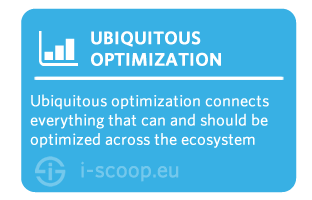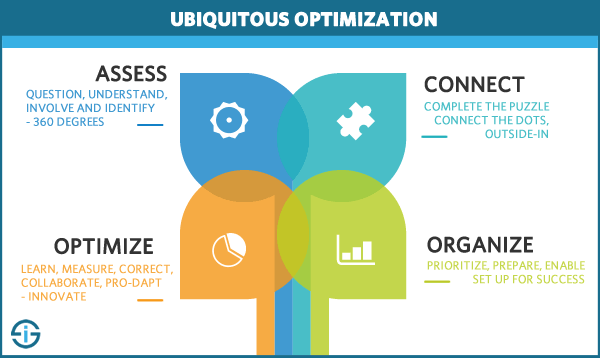 Business success requires ongoing optimization. Yet, in a connected economy isolated optimization efforts don’t cut it.
Business success requires ongoing optimization. Yet, in a connected economy isolated optimization efforts don’t cut it.
Ubiquitous optimization requires a customer-centric approach, going beyond silos and having a genuine 360° view on your organization, customers and ecosystem.
Marketing, sales, customer service, IT, collaboration, processes, employees, channels, customer value: it’s all connected. Ubiquitous optimization connects everything everywhere to optimize not just what matters but also the interconnectedness of what needs to be connected and isn’t today – always, step by step, starting now. In a prioritized way and knowing not all can be optimized nor all that needs to be optimized can be seen or predicted. Indeed: the essence of digital transformation in more than one sense.
Ubiquitous optimization is the duty of each business, each organization, each manager and each worker. It aims to create maximum business value by increasing customer value across all activities. It corresponds with the very essence of business as such – create shareholder value, create customer value, create jobs, care, innovate and adapt to ever more connected transformative challenges requiring and enabling the holistic optimization transformations organizations need. It connects all the dots that are needed to succeed in these goals and are more visible, integrated, intertwined and crucial than ever before in a digital era where hiding in silos and ignoring responsibility is not an option anymore.
What does ubiquitous optimization require?

Assess – where are you, where do you go, are you sure it’s the right direction, what’s missing?
- Take a step back from what you’re doing and where you’re heading (regularly).
- Identify the leaks, gaps and missed opportunities by measuring and listening.
- Look at the needs of your customers, teams, partners and ecosystem.
- Discover the frictions and stumbling blocks.
- Gauge the individual capabilities of your people, know what they need to succeed.
- Is leadership really leading and enabling – what does it need?
- Identify organizational issues, the number one reason standing in the way of ubiquitous optimization.
- Put people – customers, employees – first. Always. Before tools and processes and as part of the success of all tools and processes you have.
- Do not assume.
Connect – go beyond silos, connect the dots, involve stakeholders, challenge, complete the puzzle
- Organize workshops challenging yourself and your activities.
- Look beyond the front-end: connect the back-office.
- Work outside-in instead of just inside-out.
- Where are the silos – how can you work across them?
- Identify value creation opportunities but also potential cost efficiencies caused by silos, leaks and poor alignment.
- Assemble all pieces of the puzzle en route to genuine optimization for each challenge.
- Involve stakeholders, most importantly including customers (and their customers where needed), partners and external experts.
- Go beyond the individual business function. Example: when optimizing a customer-facing process involve marketing, sales, customer service but also IT, field reps, finance, product management, R&D, etc.
- Think and act beyond silos and what you know and understand. Be open for what you don’t know. Question.
Organize – prioritize, define, prepare and set up success indicators
- Select the areas where you can improve business and customer value.
- Prioritize and discover what you need to improve, looking at the full picture.
- Pick an area where you can improve right here and right now.
- Create a roadmap for future optimizations.
- Involve all stakeholders to make it happen – create agile and multi-disciplinary teams.
- Make the case – everywhere you need.
- Create a culture of ubiquitous optimization across the organization.
- Change and transform with a purpose and where needed.
- Realize change is about people and requires change management.
- Define KPIs to gauge customer and business value.
- Assign responsibilities over KPIs instead of functions.
- Make sure your teams are trained and acquire the proper skills.

Optimize – keep learning, move from essence to innovation, measure, correct, collaborate and pro-dapt.
- Focus on simplicity, ease, action and what customers – in the broadest sense – really need first.
- Improve the basics while at the same time going the extra mile where needed and/or large gains can be made (think out the box).
- Test, try, measure and reiterate or change.
- Learn, have fun, understand and enable initiative, innovation, proactivity, room for errors, feedback loops and interaction.
- Go for it, step by step and with the next steps in mind.
- Measure impact on a regular basis and improve where necessary.
- Involve the stakeholders you might (will) have missed and correct potential errors.
- Continue learning, assessing and innovating/training for present and future improvements.
- Get the cross-divisional and multi-disciplinary agile teams collaborate, realign and re-focus regularly.
- Take the next steps beyond the low hanging fruit and strengthen your culture of ubiquitous optimization.
- Keep searching for gaps and assumptions.
- Detect opportunities, monitor the evolutions in your ecosystem and pro-dapt instead of adapting.
The need for ubiquitous optimization in practice: customer experience optimization
An excellent example why ubiquitous optimization is needed, is customer experience optimization. Most organizations try to enhance the customer experience by focusing on “amazing” experiences and looking at individual touchpoints. What often misses is the essence: the basics of what people want, which is very different from what business think they want.It’s a typical example of “managing” a crucial creator of business value within silos instead of across the organization. It’s also a typical example of not involving all stakeholders. And it doesn’t end there.
Customer experience management is most of all an end-to-end activity. Yet, at the same time, negative single customer experiences can have a disastrous impact. And they do occur in areas businesses tend to overlook. Furthermore, enabling positive customer experiences is all too often a front-end activity in customer-facing functions and operations whereby the back-office is overlooked.
Spending huge amounts on customer experience optimization in direct customer touchpoints while failing in supporting follow-up processes and disappointing customers because of slow and disconnected legacy back-office systems is a recipe for failure. Last but not least, in most organizations even customer-facing functions, processes, resources (people, information) and systems are still disconnected, leading to poor overall customer experiences. An example: the disconnect between customer service and other divisions whereby a lack of leadership, vision and a 360° perspective is often key.
That’s why ubiquitous optimization always takes the full picture into account, including the human element. After all: what’s the value of great tools, processes and integrations when customer-facing employees, for instance, are not properly trained or motivated and when no one is responsible for the customer experience KPIs and impact on the bottom line?
It’s time to connect the dots.

